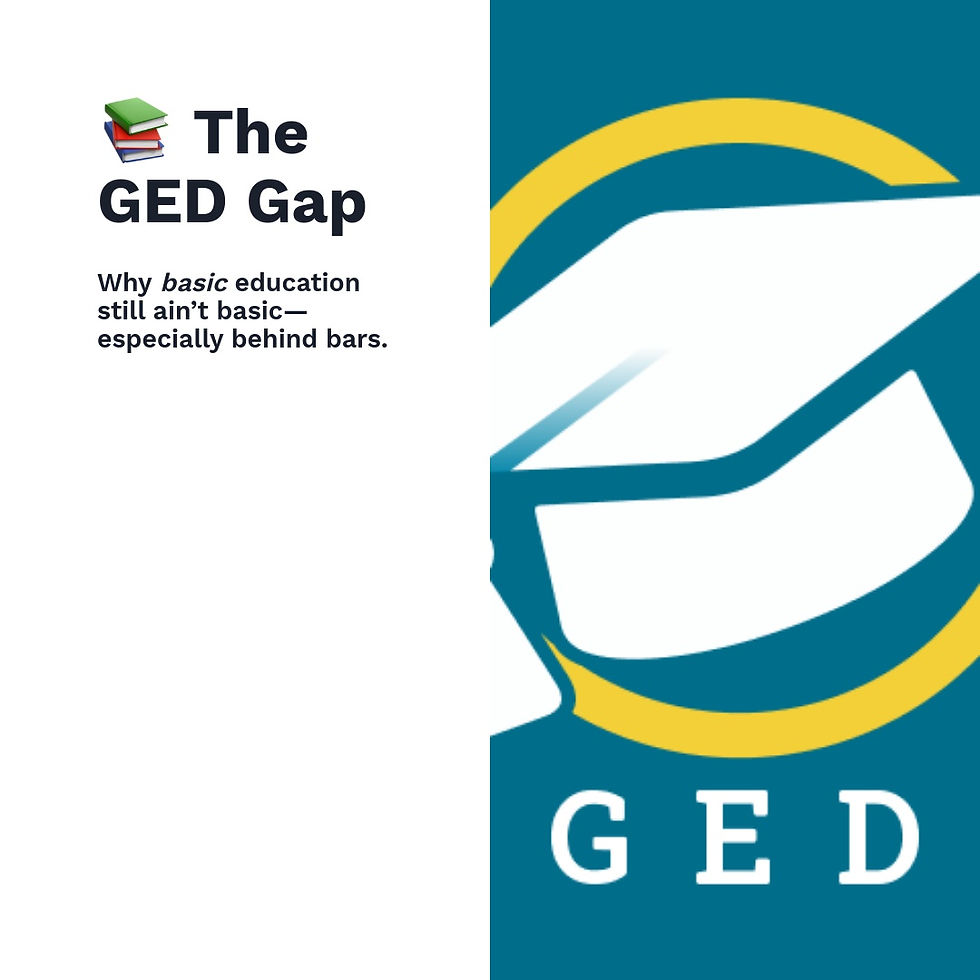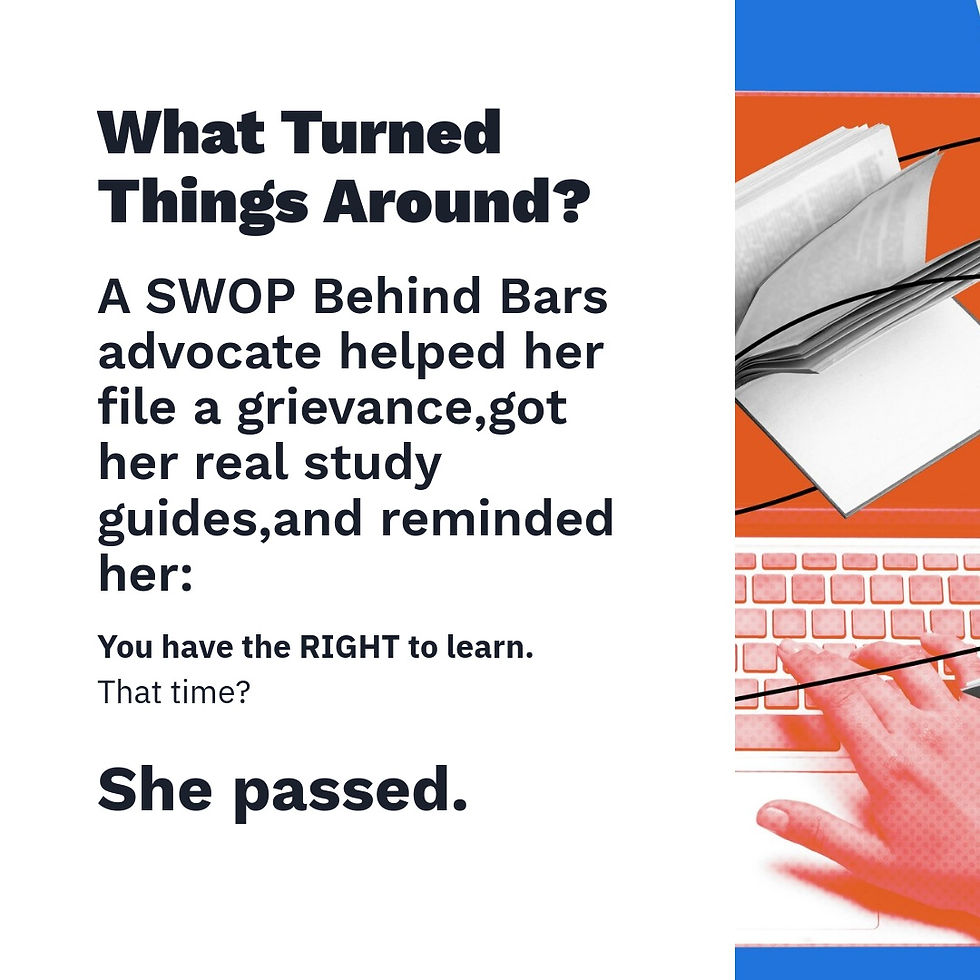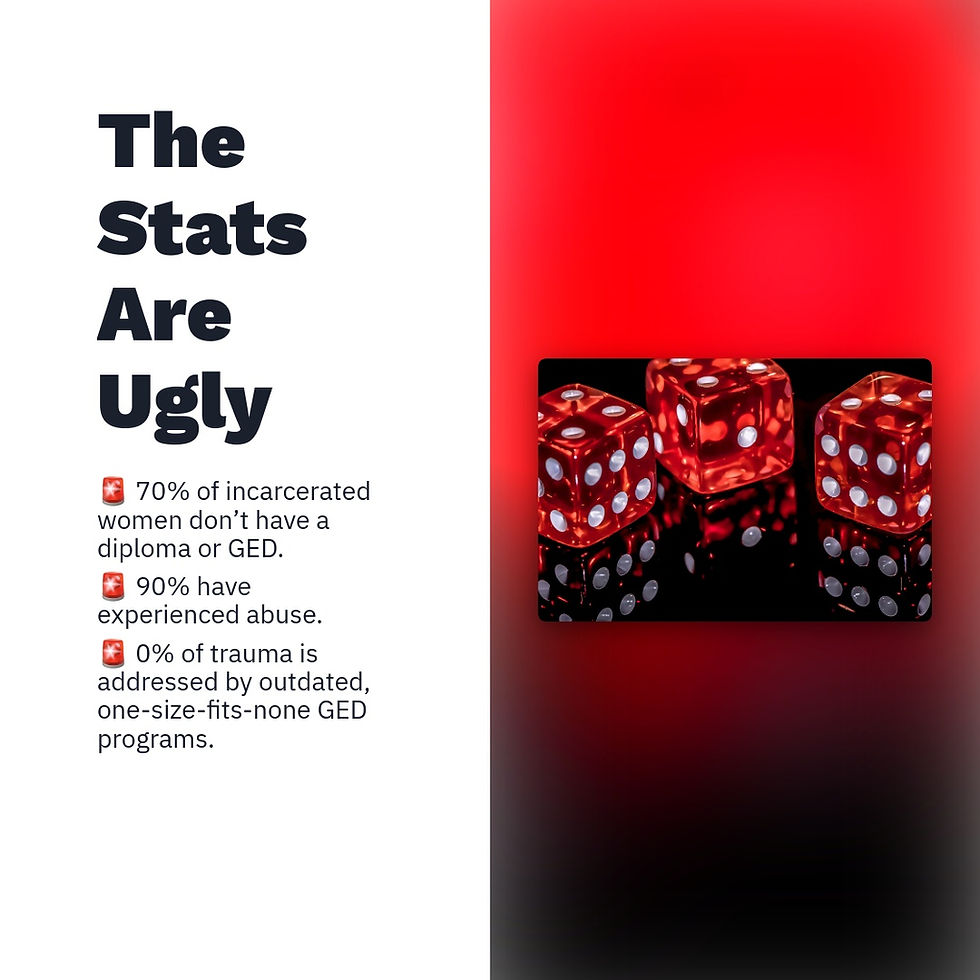The GED Gap — Why Basic Education Still Isn’t Basic (Especially if You're a Woman in a Cage)
- Swop Behind Bars

- May 30, 2025
- 5 min read
Education is often sold as the golden ticket—the “way out,” the “great equalizer,” the shiny ladder out of poverty. But for women who’ve survived violence, exploitation, poverty, and incarceration, that ladder is missing rungs, set on fire, and chained to a concrete floor. At the intersection of gender, race, trauma, and the carceral system, education isn’t just out of reach—it’s actively denied. This six-part blog series breaks down the brutal truths behind education access for criminalized women and femmes: from being pushed out of school as girls, to being locked out of classrooms in jail, to being dismissed by systems that still don’t see them as worth the investment.

We start at square one: the GED Gap—and why something as “basic” as high school equivalency remains a radical, often inaccessible act of survival.

Meet Tamika
It was her third time in county jail when Tamika finally asked about the GED class.
She was 29, a mother of two, and had been caught in the revolving door of the system since she was a teenager. Her charges always changed—survival sex work, resisting arrest, petty theft—but the root causes never did. By 15, she was being molested and traded for drugs. By 16, she was out on her own. The next decade was a masterclass in surviving without support: bouncing between couches, dodging abusive partners, and hustling in the streets just to eat.
What she wanted—more than a moment’s peace or even freedom—was a real shot. A job where she didn’t have to lie about her past. A life her kids could be proud of.
So when she asked the officer about the GED class, his response was a smirk and a punchline:“You’ll be out before we can even get you on the list. Come back next time if you’re really serious.”Translation: education in jail? Cute. Try again later.

And Tamika did come back. Not because she wanted to, but because systems designed without exits tend to reroute folks right back in. By the time she actually got into the class—during her fourth incarceration—the damage had been done. The materials looked like they were printed during the Clinton administration, the instructor was burned out, and no one explained what came after. Her PTSD made it hard to focus, and after one panic attack? She got kicked out for “disrupting the class.” Because heaven forbid we interrupt the sacred vibes of remedial math with a trauma response.

Enter SWOP Behind Bars, stage left, via a jail tablet. An advocate told her something no one had ever said out loud: you have a right to learn. Not a favor. Not a temporary privilege. A right.
They helped her file a grievance, rejoin the class, and mailed her actual study materials—ones that weren’t photocopied from a decades-old packet.
This time, she passed. And for the first time in a long time, she saw a future that wasn’t just about surviving.
Her GED wasn’t a fairytale ending—but it cracked open a door. With that one sheet of paper, she became eligible for a reentry scholarship, got into a virtual peer support program, and started working toward becoming a counselor for other survivors.
Tamika’s story isn’t unique. It’s just the kind of story that gets buried under mugshots and mugshots and mugshots. That’s why we need to talk about why basic education still isn’t basic, especially for incarcerated women trying to rewrite the script.

Basic Education: Still Not Basic. Still Not Fair.
Let’s be clear: education has always been hyped as “the great equalizer.” A ladder out of poverty. A ticket to freedom. Blah blah bootstrap narrative. But for incarcerated women—especially survivors of trafficking, abuse, and generational poverty—education isn’t just inaccessible, it’s practically mythical.
We’re talking about women who’ve been locked out long before they were locked up. And yet, somehow, a GED still manages to be treated like a luxury item instead of a baseline.

Let’s rewind.
Formal education in the U.S. wasn’t designed for everyone. It was built by and for white, land-owning men. Women were expected to read just enough to follow a recipe and obey a husband.
Black folks—especially those enslaved—were criminalized for even attempting to learn. And when that was no longer legal, the system just got sneakier: push Black kids into vocational training, keep liberal arts and leadership pipelines white.
Fast-forward to prison education, which has always been more about controlling people than empowering them. Southern prisons straight-up copied plantation models, and education for incarcerated people—especially Black folks—was seen as a threat. And when prison college programs finally gained traction in the ‘70s and ‘80s? Boom. The 1994 crime bill slashed Pell Grants, gutting access overnight. What we got in return was GED programming duct-taped together with underpaid staff and zero trauma-informed anything.

Let’s Talk Numbers (Because They’re a Mess)
Roughly 68% of people in state prison don’t have a high school diploma. For women? Over 70%. That’s not just a number—it’s an indictment. These women didn’t “drop out”—they were pushed out. Disrupted education, trauma, poverty, foster care, teen pregnancy. And when schools used zero-tolerance policies to shove them into juvenile court, guess what wasn’t waiting on the other side? A classroom.
Once inside prison, the problems don’t go away—they just get new uniforms. Waitlists. Mandatory work shifts scheduled over class time. Mental health challenges ignored. Solitary confinement = no education. Learning disability? Sorry, try being “normal” first. Oh, and if your trauma makes you dissociate mid-test? Better luck next sentence.
Meanwhile, the world outside keeps spinning, and every job, housing application, or custody hearing wants to know: “Do you have a diploma?” No GED means no shot. Full stop.
Time to Stop Treating Education Like a Prize
Basic education in prison should not be treated like a carrot on a stick. It’s a right, not a reward for “good behavior.” We need trauma-informed teaching, learning accommodations, and a serious overhaul of how we design these programs. Otherwise, we’re just locking women in a cycle of exclusion.
And let’s not forget what happens after release. A GED without a plan is like handing someone a key to a house that doesn’t exist. We need bridges to college, trade school, and job pathways. Real support. Real investment. Not just “Congrats on the GED, don’t come back now!”

Let’s Get Real
Education is not optional. It’s survival. It’s safety. It’s power. For our community—women and femmes who’ve survived violence, incarceration, and state neglect—it’s one of the few tools that can actually rewrite a life.
But that tool doesn’t work if it’s locked in a broken system.
So here’s your reminder: basic education still isn’t basic if you have to fight this damn hard to get it.
And we’re not done fighting.

Join Us!
Join SWOP Behind Bars in our mission to connect our inside community to our outside community where they can receive the kind of dignity and respect they deserve!
Donate you time, talent or treasure at out website: www.swopbehindbars.org and keep us with what we are doing to reduce recidivism, improve health and safety for women and create new and sustainable pathways to independence for our clients!
Next Up in the Series: Correspondence Course Hustle: Higher Education from a CellBecause trying to earn a college degree from behind bars is its own saga of red tape, fees, and confusion. Spoiler: it's not as empowering as the brochures make it sound.




It resonates with my own experiences navigating societal expectations and personal challenges, which sometimes felt like a test of my resilience, much like the rice purity test. The systemic issues outlined here highlight how crucial it is to advocate for equitable access to education, not just as a privilege but as a fundamental right. We must continue to fight for these women and ensure their voices are heard.